高中英语UNIT1CULTURALHERITAGESectionⅡReadingandThinking课件新人教版必修第二册
- 格式:ppt
- 大小:7.62 MB
- 文档页数:77
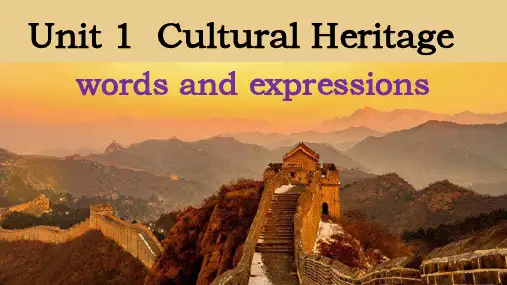
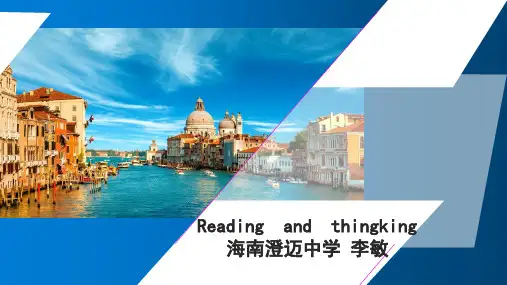
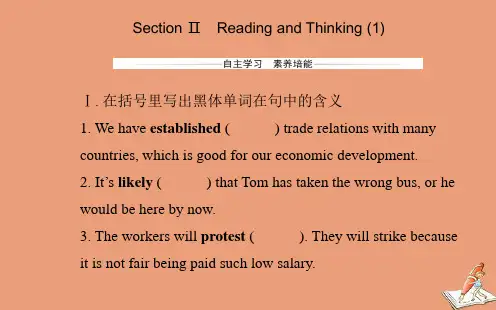
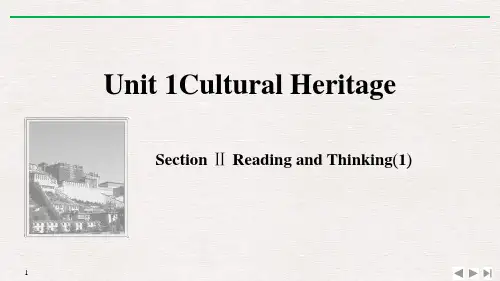
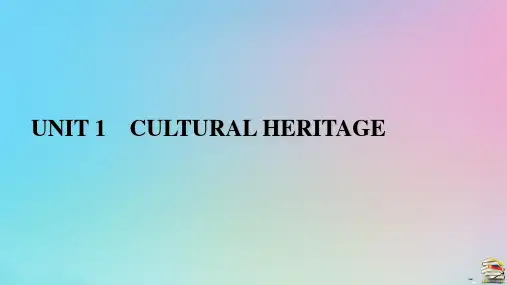
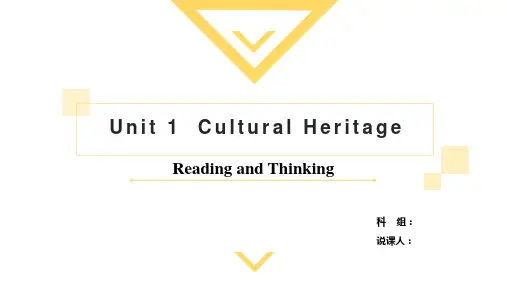
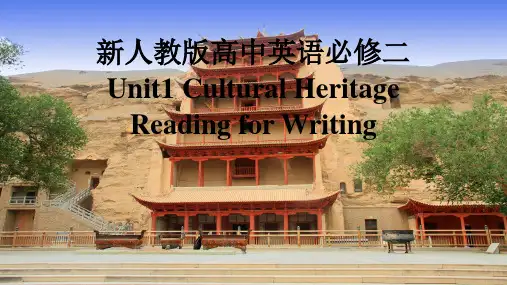
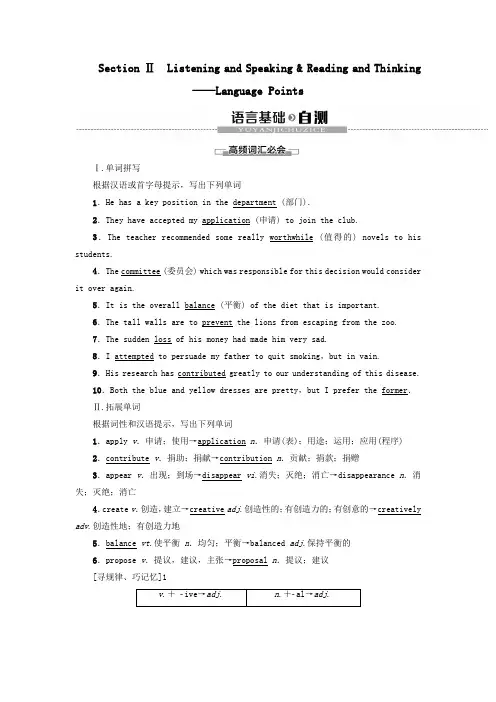
Section ⅡListening and Speaking & Reading and Thinking——Language PointsⅠ.单词拼写根据汉语或首字母提示,写出下列单词1.He has a key position in the department (部门).2.They have accepted my application (申请) to join the club.3.The teacher recommended some really worthwhile (值得的) novels to his students.4.The committee (委员会) which was responsible for this decision would consider it over again.5.It is the overall balance (平衡) of the diet that is important.6.The tall walls are to prevent the lions from escaping from the zoo.7.The sudden loss of his money had made him very sad.8.I attempted to persuade my father to quit smoking,but in vain.9.His research has contributed greatly to our understanding of this disease.10.Both the blue and yellow dresses are pretty,but I prefer the former.Ⅱ.拓展单词根据词性和汉语提示,写出下列单词1.apply v.申请;使用→application n.申请(表);用途;运用;应用(程序)2.contribute v.捐助;捐献→contribution n.贡献;捐款;捐赠3.appear v.出现;到场→disappear vi.消失;灭绝;消亡→disappearance n.消失;灭绝;消亡4.create v.创造,建立→creative adj.创造性的;有创造力的;有创意的→creatively adv.创造性地;有创造力地5.balance vt.使平衡n.均匀;平衡→balanced adj.保持平衡的6.propose v.提议,建议,主张→proposal n.提议;建议[寻规律、巧记忆]1v.+ive→adj. n.+al→adj.active adj.活跃的addictive adj.上瘾的creative adj.有创造力的environmental adj.环境的personal adj.个人的musical adj.音乐的Ⅲ.补全短语根据提示补全下列短语1.take part in 参与(某事);参加(某活动)2.give way to 让步;屈服3.keep balance 保持平衡4.lead to 导致5.make a proposal 提出建议6.turn to 向……求助7.prevent...from... 阻止;阻碍;阻挠8.donate...to... 向……捐赠……9.run over 撞倒并碾轧;驱车送;快速阅读Ⅳ.选词填空选用上述短语的适当形式填空1.In given conditions,a bad thing can lead to good results.2.I hope that all of you can take part in the sports meeting for the honour of our class.3.The manager made a proposal for uniting the two companies last year.4.He was turned to for advice by all sorts of people in the past.5.At first he said nothing,and then his silence gave way to anger.[寻规律、巧记忆]2v.+to→动词短语vt.+n.+prep.→动词短语belong to属于refer to 参阅,谈及turn to 求助于;转向take care of照顾catch sight of看见;看到do harm to对……有害背教材原句记句式结构仿写促落实1.There comes a time when the old must give way to the new,and it is not possible to preserve a time + when引导的定语从句It was a time when I wasaddicted to playingcomputer games;how Ieverything from our past as we move towards the future.新旧更替的时代已经到来,在走向未来的过程中,我们不可能将过去的一切都保存下来。
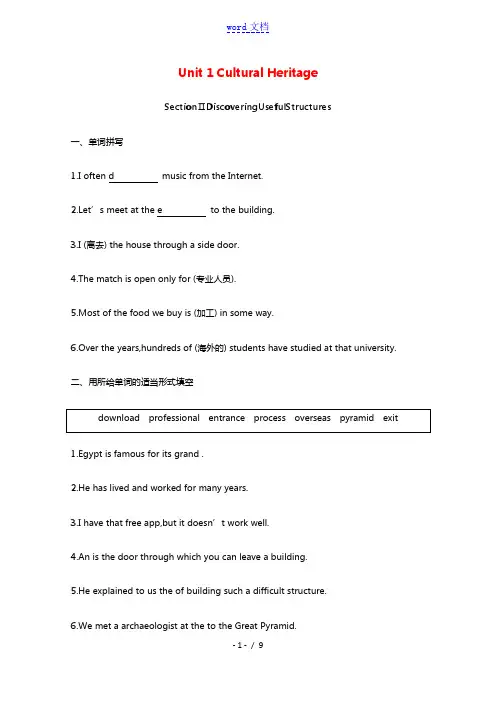
Unit 1 Cultural HeritageSectionⅡDiscoveringUsefulStructures一、单词拼写1.I often d music from the Internet.2.Let’s meet at the e to the building.3.I (离去) the house through a side door.4.The match is open only for (专业人员).5.Most of the food we buy is (加工) in some way.6.Over the years,hundreds of (海外的) students have studied at that university.二、用所给单词的适当形式填空1.Egypt is famous for its grand .2.He has lived and worked for many years.3.I have that free app,but it doesn’t work well.4.An is the door through which you can leave a building.5.He explained to us the of building such a difficult structure.6.We met a archaeologist at the to the Great Pyramid.三、用适当的关系词填空1.There is a table in the house on there are some apples.2.We settled down in a small village in front of ran a winding river.3.We’ll go to hear the famous singer about we have often talked.4.The school he once studied lies in the east of the town.5.There are sixty students in our class,thirty of are girls.6.Do you remember the days we played together?7.The plane in we flew to Shanghai is very fortable.四、用“介词+关系代词”填空1.As is known to us all,the age children can go to school is seven.2.Believe it or not,I don’t like the way he spoke to me.3.Mrs Zhang often tells us that spring is the time people go sightseeing.4.The bike he went to school was stolen last week,which made him feel sad.5.Thank you for your help, we could not have finished the work in time.6.Who do you suppose is the man our teacher is talking?7.Do you remember the building flew a red flag all the year round?8.This is the book I spent 10 yuan.9.Do you remember the year you first visited Beijing?五、用适当的介词填空1.Do you like the book which she paid $10?2.Do you like the book which she learned a lot?3.Do you like the book which she often talks?4.The library which students often study was on fire last night.5.The reason which he didn’t e was that he was ill.6.I’ll never forget the time which I lived in the countryside.7.She didn’t know the teacher whom I turned for advice.8.China has a lot of rivers,the second longest which is the Yellow River.六、阅读理解AThe Taj Mahal(泰姬陵) is considered to be one of the most beautiful buildings in the world and the finest example of the late style of Indian architecture.It is in northern India.It lies beside the River Jumna in the middle of gardens with quiet pools.The Taj Mahal was built by the Mogul emperor(皇帝) Shah Jehan,who ruled India in the seventeenth century.It is in memory of his favourite wife,Arjumand BanuBagam,known as Mumtaz Mahal,who died in 1631.The building,which was pleted between 1632 and 1638,was designed by a local Muslim architect(建筑师),Ustad Ahmad Lahori.The whole building,with gardens and gateway structures,was pleted in 1643.The Taj Mahal stands at one end of the garden tomb with marble(某某石) paths.The room is softly lighted by the light that passes through double screens of carved marble set high in the walls.The building now is kept in good condition.The Taj Mahal took 22 years to build.Shah Jehan planned a similar building,but in black instead of white,to lie on the other side of the river.But before it could be built,Shah Jehan was imprisoned(监禁) by his son and buried next to his wife in the Taj Mahal.1.The Taj Mahal was built for.C.either Mumtaz or ShahD.both Mumtaz and Shah2.The passage mainly tells us .A.why the Taj Mahal was builtB.the love story between Shah and MumtazC.some information about the Taj MahalD.the Taj Mahal—the pride of Indians3.From the passage we can learn that .A.the Taj Mahal looks more beautiful than beforeB.the Taj Mahal doesn’t exist nowC.the Taj Mahal has pletely changedD.the Taj Mahal has bee a place of interestBTake a look at teenagers around,dressed in baggy-pants,drinking soft drinks such as coke,reading Japanese cartoons.Whether you are in Beijing,Wuhan or Hong Kong,you will get the same impression.But should we copy others or should we maintain our differences?It sounds convenient that people around the world speak the same language,dress in the same style,eat the same food and play the same games.If the world was like this,you won’t feel strange in any corner of the world.But just imagine living in such a strange world.How dull and colourless it would be!Different kinds of food that people can taste,the colourful and fashionable clothes that we dress in and different languages we speak are all part of the different cultures that our ancestors left us.These differences represent their creativity and talent.And we all enjoy different cultures in our daily lives.When you travel to otherplaces,you want to see different things.When you talk to foreigners you expect to listen to interesting stories.These differences in culture are what make life colourful.But the whole world is shrinking into a small village as globalisation takes effect and many different cultures are disappearing.In most big cities around the world people wear the same clothes.Fast food stores are everywhere.Hollywood movies are kicking traditional performing arts out of our lives.The colours of our life are disappearing.There is a joke that even the panda and the zebra want to live a colourful life.So let’s take action to protect our colourful culture before it bees as simple as black and white.It’s not difficult.Learning some folk songs,trying on a traditional clothing and even eating local food instead of going to KFC can help.And we’re sure you will enjoy it.4.The author starts the argument by .A.mentioning certain cultural phenomena(现象)B.mentioning his view at the very beginningC.mentioning the opposite view at the very beginningD.giving examples of cultural differences5.The underlined word “shrink”probably means “”.A.expandC.bee smallerD.grow in number6.The author talks of all the following cultural phenomena except .七、语篇填空A Frenchman went to a small Italian town and stayed with his wife at the best hotel there.One night,he went out for a walk alone.It was late and the small street was dark and quiet.1.(sudden) he felt someone behind him.He turned his head and saw an Italian young man who walked past him quickly.The man was nearly out of sight when the Frenchman found that his watch was 2.(go).He thought that it must be the Italian 3. had taken his watch.He decided 4.(follow) him and get back the watch.Soon the Frenchman 5.(catch) up with the Italian.6. of them understood the other’s language.The Frenchman frightened the Italian with his fist(拳头) while7.(point) at the Italian’s watch.In the end the Italian gave up his watch to the Frenchman.When he 8.(return) to the hotel,the Frenchman told his wife what had happened.He was greatly 9.(surprise) when his wife pointed to the watch on the table.Now he realised that he had robbed the watch 10.mistake.答案:一、1.download 2.entrance 3.exited4.professionals 5.processed 6.overseas二、1.pyramids 2.overseas 3.downloaded4.exit 5.process6.professional;entrance三、1.which 2.which 3.whom 4.where5.whom 6.when 7.which四、1.at which 2.in which 3.during which4.on which 5.without which6.to/with/about whom7.over which8.on which9.in which五、1.for 2.from 3.about 4.in 5.for 6.during 7.to 8.of六、1.A 根据第二段中的“Itisinmemoryofhisfavouritewife,ArjumandBanuBagam,knownasMumtazMahal,who diedin1631.”可知,泰姬陵是为了Mumtaz而建立的。
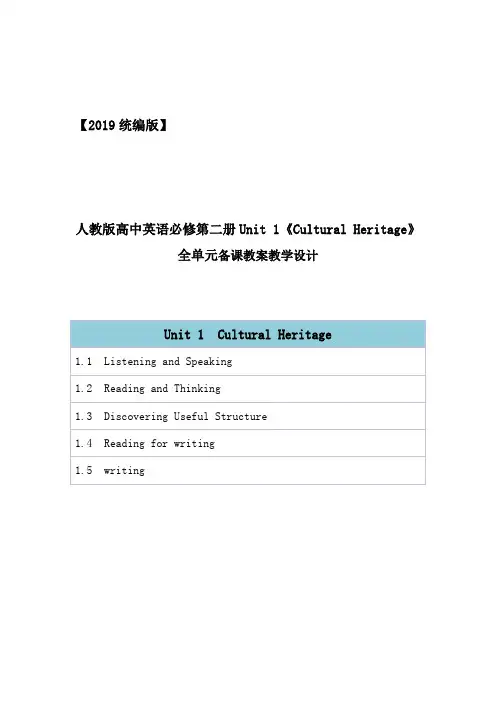
【2019统编版】人教版高中英语必修第二册Unit 1《Cultural Heritage》全单元备课教案教学设计Unit 1 Cultural HeritagePeriod 1 Listening and Speaking【教材分析】Listening and Speaking introduces the topic of “Take part in a youth project”.The listening text is an interview about an international youth cultural heritage protection project. More than 20 high school students from seven countries participated in the project. The reporter interviewed two participants Stephanie and Liu Bin. By listening to the text, students can understand the significance of cultural heritage protection, and teenagers can use their knowledge, combine their own interests and advantages, etc. to participate in the action of cultural heritage protection.Listening and Talking introduces the theme of “Talk about history and culture”.The listening text is a dialogue between two tourists and tour guides when they visit the Kremlin, Red Square and surrounding buildings. The dialogue focuses on the functional items of “starting a conversation”, which is used to politely and appropriately attract the attention of the others, so as to smoothly start a conversation or start a new topic. The purpose of this section is to guide students to understand the history and current situation of Chinese and foreign cultural heritage in their own tourism experiences or from other people’s tourism experiences, explore the historical and cultural values, and be able to express accurately and appropriately in oral communication.【教学目标】1. Guide students to understand the content of listening texts in terms of the whole and key details;2. Cultivate students’ ability to guess the meaning of words in listening; discuss with their peers how to participate in cultural heritage protection activities.3. Instruct students to use functional sentences of the dialogue such as “I beg your pardon, but…” “Forgive me for asking, but…” and so on to start theconversation more politely and appropriately.【教学重难点】1. Guide students to understand the content of listening texts in terms of the whole and key details;2. Cultivate students’ ability to guess the meaning of words in listening; discuss with their peers how to participate in cultural heritage protection activities.3. Enable students to use the functional items of “starting a conversation”, which is used to smoothly start a conversation or start a new topic.【教学过程】Part 1: Listening and SpeakingStep 1: Lead inThe teacher is advised to talk about the meaning of the word “Heritage”.Boys and girls, before our listening, let’s work in pairs and discuss the meaning of the word “Heritage”.What does the word “heritage” mean? Share your ideas about your understanding of it and you can use examples to illustrate your meaning.Heritage means the traditional beliefs, values, customs, etc. of a family, country or society.For example, the Great Wall is the heritage of China.Step 2: PredictionAfter their small talk, the teacher can ask students to predict what the listening text is about by looking at the pictures.The listening text is probably about how to protect a famous heritage site by some students.Step 3: Summary of the main ideaThen play the radio which is about an interview about an international youth cultural heritage protection project. And after finishing listening for the first time, the students need to solve the following tasks.1. Listen to the conversation and sum up the main idea.Youths from seven countries are working together to protect cultural relics on Mount Tai.2. Listen again and help the reporter to complete the interview notes.International youth project, 23 high school students from 7 countriesMount Tai, one of the most famous mountains in ChinaIt has been protected for more than 3,000 years.22 temples, around 1,800 stones with writing on themStep 4: Guessing the meaning of the unknown wordsListen to the conversation again and use the context to guess the meaning of the words below. Tell the reasons why you guess so.Preserve: to protectReason: the word means the same of a word I knowPromote: to help sth to happen or developReason: The word is explained by the speakerStep 5: Speaking ProjectWork in pairs or groups and role play a conversation.Suppose you are a reporter and interviewing the students who devote their time to protecting the heritage.Reporter: It is said that you are one of the volunteers to preserve the pine trees on Mount Huang. What are you guys doing?V olunteer: We are making some signs which are designed to educate people to protect the pine trees.V olunteer: Besides, we took a lot of pictures of pine trees and create an app which aims to promote people’s awareness of protecting the precious trees.Reporter: Sounds great and anything else?V olunteer: We often wear volunteer clothes and send some brochures in the park to call on more people to protect the trees.Reporter: Does your hard work pay off?V olunteer: Definitely. More and more tourists are now stopping carving names on the trees or climbing the trees.Part 2: Listening and TalkingStep1: Listen to the tape, which is about a dialogue between two tourists and a tour guide when they visit the Kremlin, Red Square and surrounding buildings for the first time, and then ask the students to solve the following tasks.1. Listen to the conversation and answer(1).Where are the speakers?On a street.(2).What are they doing?Sightseeing.2. What do you know about the Kremlin and Red Square? Listen again and complete the fact sheet.Step 2: Speaking ProjectActivity 3 on page 7.Work in groups. Choose a cultural site that you like and role-play a conversation between some tourists and their tour guide. Take turns to play the different roles.Step 3 HomeworkAccording to Activity 3, write down a conversation between the tourist and his/her guide.Unit 1 Cultural HeritagePeriod 2 Reading and Thinking【教材分析】1. This section focuses on “Understanding how a problem was solved”, which is aimed to guide students to analyze and discuss the challenges and problems faced by cultural heritage protection during the construction of Aswan Dam, as well as the solutions. On the basis of understanding, students should pay attention to the key role of international cooperation in solving problems, and attach importance to the balance and coordination between cultural heritage protection and social and economic development. Students are encouraged to face challenges actively, be good at cooperation, and make continuous efforts to find reasonable ways and means to solve problems.【教学目标】1. Enable students to understand the main information and text structure of the reading text;2. Motivate students to use the reading strategy “make a timeline” according to the appropriate text genre;3. Enable students to understand how a problem was solved;4. Enable students to understand the value of protecting cultural heritage by teamwork and global community;【教学重难点】1. Guide students to pay attention to reading strategies, such as prediction, self-questioning and scanning.2. Help students sort out the topic language about protecting cultural relics and understand the narrative characteristics of “time-event” in illustrative style3. Lead students to understand the value of protecting cultural heritage by teamwork and global community;【教学过程】1. PredictionStep 1 Predicting the main idea of the passageLook at the title and the pictures, and then predict what the passage will be about.Q: What will be talked about?Step 2: Fast reading tasksTask of the first fast reading:Read quickly and figure out the key words of each paragraph.•Paragraph 1: challenge•Paragraph 2: proposal led to protests•Paragraph 3: committee established•Paragraph 4: brought together•Paragraph 5: success•Paragraph 6: spiritTask of the second fast reading:1. Why did the Egyptian government want to build a new dam in the 1950s?2. Why did the building of the dam lead to protests?3. How did the government save the cultural relics?4. Which one can describe the project?A. Successful.B. Negative.C. Useless.D. Doubtful.5. What can be learned from the Aswan Dam project?Step 3: Careful reading tasksRead more carefully and answer the following questions.1. What do “problems” refer to and what do “solutions” refer to?2. Find out the numbers in paragraph four and explain why the author used exact numbers instead of expressions like many?3. What can you infer from “Over the next 20 years, thousands of engineers and workers rescued 22 temples and countless cultural relics”?4. What can you infer from “Fifty countries donated nearly 80 million to the project”?The project cost a lot of money.5. Before the building of the dam, what problems did the Nile River bring to theEgyptian?6. What words can you think of to describe the working process of the project?Step 4: ConsolidationDivide the passage into three parts and get the main idea of each part.Part 1 (Paragraph 1)The introduction of the topicKeeping the right balance between progress and the protection of cultural sites is a big challenge.Part 2 (Paragraphs 2-5)The process of saving cultural relics•Big challenges can sometimes lead to great solutions.•The Egyptian government wanted to build a new dam, which would damage many cultural relics.•The government turned to the UN for help.•Experts made a proposal for how to save cultural relics after a lot of efforts and the work began.•Cultural relics were taken down and moved to a safe place.•Countless cultural relics were rescued.•The project was a success.Part 3 (Paragraph 6)The summary of the textThe global community can sometimes provide a solution to a difficult problem for a single nation.Step 5: Critical thinking:1. How to deal with the construction and the protection of cultural relics?2. As students, what should we do to protect our cultural relics?Step 6: summaryStep 7 Homework:Review what we have learned and find out the key language points in the text.Unit 1 CULTURAL HERITAGEReading for Writing【教学目的与核心素养】1. Get students to have a good understanding of some features about a news report by reading the text.2. Instruct students to write a summary about a news report properly using some newly acquired writing skills in this period.3. Develop students’ writing and cooperating abilities.4. Strengthen students’ great interest in writing discourses.【教学重难点】1. Stimulate students to have a good understanding of how to a summary about a news report2. Cultivate students to write a news report properly and concisely.【教学过程】Step 1 Lead inDo you think it is necessary for us to circulate our cultural heritage to the world? Why or why not?Do we need to learn more about other countries’ cultural heritage? Why or why not?Step 2 Read to discover details concerning the main body of the news report Read the news report and then solve the questions below.1. What are the researchers and scientists trying to do?(The researchers and scientists are trying to increase knowledge and appreciation of China’s ancient cultural heritage.)2. What modern technology are they using?(They are using digital photography to record a collection of images.)3. Why are so many people interested in the Mogao Caves?(People are interested in the Mogao Caves because they have long been a meeting point for different cultures and are part of the history of many countries.)4. What do you think of the researcher’s opinion in the last paragraph?(I agree with the researcher’s opinion. Understanding our own and other cultures is a great way to understand ourselves and others.)Have the Ss discuss the questions in groups and then share their answers to the class.Step 3: Study the organization and language features1. Read the news report again and find these parts.A. Lead sentenceLanzhou, 9 August 2017. A group of researchers and scientists from China and other countries are working together ... China’s ancient cultural heritage.B. Direct quote“Appreciating one’s own cultural heritage is very important for understanding ourselves. Appreciating the cultural heritage of other countries is very important for international communication and understanding.”C. ParaphraseThey are recording and collecting digital images of cultural relics from the Mogao Caves, which were a key stop along the Silk Road throughout China’s ancient history. Nearly 500,000 high-quality digital photographs have been produced since the international project started in 1994.D. Background informationThe Mogao Caves have long been a meeting point for different cultures and are part of the history of many countries.E. Reporting verbsF. Words to show comparison and/or contrastToday, the caves are just as interactional as they were at the time when people travelled the Silk Road.2. Underline the relative clauses that the writer uses to identify the following.A. thingsThey are recording and collecting digital images of cultural relics from the Mogao Caves, which were a key stop along the Silk Road throughout China’s ancient history.B. peopleAs one researcher who is working on the project explains, “Appreciating one’s own cultural heritage is very important for understanding ourselves. Appreciating the cultural heritage of other countries is very important for international communication and understanding. ”C. timeToday, the caves are just as interactional as they were at the time when people travelled the Silk Road.Step 4 Post reading for further summary and understanding1. Why does the writer use the quote in the report?The writer uses quotes in order to make the news report more concise, authentic and persuasive.2. Explain your understanding of the sentences: “Appreciating one’s own cultural heritage is very important for understanding ourselves. Appreciating the cultural heritage of other countries is very important for international communication and understanding.”We should learn and understand our own cultures, which is vital for us to know ourselves and be proud of our profound and extensive cultural heritage. Meanwhile, we should understand and appreciate other cultures, trying to be open-minded. This way, we can deepen each other’s understanding and respect.Step 5 HomeworkWrite a news report about Li Hua who works to protect our cultural heritage using the following notes and you can add details to make the news report more concise and detailed.▪Name: Li HuaPlace: Xi’anProfession: a senior high school teacher▪wants to preserve cultural heritage:▪protect old houses▪takes photos of old buildings▪helps repair buildings▪looks for cultural relics▪ interviews old people▪ shows cultural relics to the public ▪ writes about the buildings …Section ⅤWriting关于文化遗产保护的新闻报道文体感知1.新闻报道是对最近发生的重大事件、重要人物进行简要而迅速地报道。
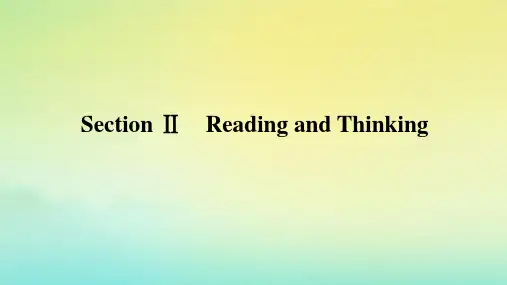
课时作业1Unit 1 Section ⅡReading and ThinkingⅠ.阅读理解ANo one can believe that the Great Wall might disappear some day. Believe it or not, the Great Wall is being destroyed by people. Less than 20 percent of the Great Wall built in the Ming Dynasty is still perfect, but about 80 percent is in danger. The Great Wall can be called “great” mostly because of its amazing length. But we should realize that the length was made up of one brick at a time. If we do nothing to save the Great Wall, it will become a series of separate wasteland rather than a historic site.The Great Wall is actually a series of walls built and rebuilt by different dynasties over the past 2,000 years. It began in the rule of China's first emperor, Qin Shihuang of the Qin Dynasty, and lasted into the Ming Dynasty. The parts built before the Ming Dynasty have nearly disappeared. People are familiar with sections such as Badaling in Beijing and Jiayuguan in Gansu because they have been open to tourists for many years. But_those_sections_far_away_from_the_public_eyes have been almost forgotten.Few local people knew the 3metrehigh walls made of earth and stones beside them are part of the Great Wall. The lack of knowledge is considered as one of the main reasons.The bricks on the Great Wall were carried off by local countryside people to build their houses, sheep corrals (畜栏) and pigsties (猪圈). Some were taken away to build roads. Bricks carved with people's names are put away as remembrance (纪念). Rubbish is spread over the battlements (城垛). The bricks can be sold for 15 yuan per tractor load. Those who destroyed and are destroying the Great Wall know its name, but are not clear about its cultural meaning. It will take a long time to let them know this. The local farmers not only carried off the body of the Great Wall but dug out the entire base.It is necessary to preserve the Great Wall. The officials should be aware of the importance of the Great Wall. Young Chinese should know more about the nation's great civilization and learn to love it.【语篇解读】历史文化古迹——长城正在遭到破坏,作者呼吁人们要保护好长城。
Unit 1 Culture Heritage单元语言点总结Heritage is our legacy from the past,what we live with today ,and what we pass on to future generations.——World Heritage Center 文化遗产是过去人类所创造,由现代人类继承并传之后世。
——世界遗产中心PartI Listening and Speaking(P23)1.take part in a youth project 加入一个青年课题2.work creatively 创造性地工作3.protect a temple in China 保护中国寺庙4.work together to do sth. 一起合作做某事5.protect culture relics 保护文化遗迹6.Mount Tai 泰山7.doing a project on... 做一个关于...的课题8.cultural heritage protection 文化遗产保护9.stones with writing 写着字的石头10.Dai temple 岱庙11.over 6000 steps 超过6000个台阶12.study old photos 研究老照片13.the former...the latter... 前者...后者...14.six cypresses 六棵柏树15.be able to... 能够16.create an app about... 开发一个关于...的应用程序17.the purpose of... ...的目的是18.introduce sth. to sb. 把某事介绍给某人19.in a fun and easy way 以一种快乐且简单的方式20.take photos of the temples and stones 给寺庙和石头拍照片21.be proud to... 以...而自豪22.across the street 路对面cross the street 穿过马路(cross是动词,穿过;across是副词,在...对面)23.referred to the guidebook 参考这本指导书preferred the guidebook 更喜欢这本指导书24.follow its trail跟随着它的踪迹follow its tail跟着它的尾巴(trail 踪迹/痕迹;tail尾巴)25.a difficult context一个困难的环境a difficult contest一场困难的考试(context:环境,语境,上下文;contest:考试,竞赛)26.the light green trays 浅绿色的文件夹the dark green trains 深绿色的火车PartII Reading and Thinking (P45)27.how a problem was solved 一个问题如何被解决(be+过去分词构成被动语态)28.economic development 经济的发展29.there es a time when... ...时代到来30.it is not possible to do sth. 做...是不可能的31.preserve everything from our past 保护我们过去的一切32.move towards the future 迈向未来33.find and keep balance between...and... 寻求和保持...和...之间的平衡34.cultural sites 文化遗址35.a big challenge 一个巨大的挑战36.lead to great solutions 带来伟大的解决方案37.the Egyptian government 埃及政府38.build a new dam 修建一个新的大坝39.across the Nile 横跨在尼罗河上40.control floods 防洪41.produce electricity 发电42.supply water to more farmers 为更多的农民供水43.in the area 在这个区域44.the proposal led to the protests 提案带来了抗议45.be likely to... 很可能...46.destroy cultural relics 摧毁文化遗产47.turn to sb. for help 转向寻求某人的帮助48.establish a mittee 建立一个委员会49.limit damage to 限制对...的破坏50.prevent the loss of... 组织...的丧失51.ask for contributions 寻求贡献52.different departments 不同的部门53.raise funds 筹钱集资54.investigate the issue 调查问题55.conduct several tests 进行了多项测试56.make a proposal 提出建议57.sign a document 签署文件58.bring together 召集59.environmentalists from around the world 世界各地的环境保护主义者60.take down 拆除61.piece by piece 一片接一片;一部分一部分地62.put back together again 再次拼接到一起63.countless cultural relics 不可计数的文化遗产64.donate to the project 为项目捐款65.it is considered that... 人们认为....66.a great success 一个巨大的成功67.found a path to... 找到...之路68.run over the relics of the past 牺牲古迹遗产(run over:(车辆)撞到并碾压;翻阅,快速阅读;摧毁,遗忘,牺牲)69.build a better tomorrow 建立更美好的明天70.the spirit of... ...的精神71.the Aswan Dam project 阿斯旺大坝工程72.run a programme 运营一个项目73.prevent from... 防止...74.provide a solution 提供解决方案75.make a timeline 制作一个时间轴76.attempt the building of the dam 尝试修建大坝77.plete the project 完成项目78.suggest a suitable title 建议一个合适的标题79.give one’s view on... 某人就...发表看法80.the new proposal 新的提案81.put...in danger 将...置于危险境地82.end her speech 结束她的演讲83.prevent from being harmed 防止被破坏(be+过去分词构成被动语态)84.contribute funds 贡献资金85.offer helps 提供帮助PartIII Discovering Useful Structures (P6)——限制性定语从句(3)复习86.in detail 详细地87.discuss briefly 简短的讨论88.make a short summary 做一个简短的总结89.in a table or mind map 在表格或思维导图里面90.download the free app 免费app91.the United Republic of Tanzania 坦桑尼亚共和国92.a professional archaeologist 一个专业的考古学家93.at the entrance to... ...的入口94.the Great Pyramid 金字塔95.explain to us 给我们解释96.the process of... ...的过程/步骤97.build such a difficult structure 建造一个如此困难的建筑98.day and night 夜以继日99.for the next generation 给下一代100.it can be deleted 它可以被删除101.go without... 没有...而勉强应付;没有...也行102.a football coach 一个足球教练PartIV Listening and Talking(P7)103.go sightseeing 去观光104.the Moscow Kremlin 克里姆林宫105.Red square 红场106.the fact sheet 资料页107.place for parades 阅兵游行的地方108.ice hokey game 冰上曲棍球比赛109.Xuanyuan Mirror 轩辕镜110.tell right from wrong 辨别是非111.the carving on the roof 屋顶上雕刻的图案112.the Forbidden City 紫禁城113.forgive me for asking 原谅我问一下PartV Reading for Writing (P89)114.write a news report 写一篇新闻报道115.promoting culture through digital images 通过数码图像推广文化(through:通过)116.increase knowledge and appreciate of... 增长对...的认识与欣赏117.digital images 数码图像118.Mogao caves 莫高窟119.a key stop along the Silk Road 丝绸之路上的关键节点120.highquality digital photographs 高质量的数码照片121.a meeting point 交汇点,汇合点122.Getty Museum in Los Angeles 洛杉矶的盖蒂博物馆123.a copy of... ...的复刻124.promote wide interest in... 激发对...的广泛兴趣125.further education 继续教育126.safeguarding historic and culture relics 保护历史和文化遗迹127.the researcher’s opinion 研究者的观点128.lead sentences 导语129.direct quote 直接引语130.interview notes 采访笔记PartVI Assessing your progress (P1011)131.get sb. to do sth. 让某人做某事132.introduce them to their country’s history 让他们了解他们国家的历史133.narrow thinking 狭隘的思想134.motivate sb. to do sth. 刺激某人做某事135.e up with 想出(办法)136.one possible idea is... 一个可能的主意是...137.intangible cultural heritage 非物质文化遗产138.give us a task 给我们一个任务139.go on field trips 进行野外考察140.be familiar with 对...熟悉141.have some symbolic meaning 有象征意义PartVII Video time (P12)142.the largest structure 最大的建筑143.one of great wonders of the world 世界奇迹之一144.The surveyors is studying the Great Wall (文物)鉴定人正在考察长城145.speed up 加速146.fall into ruins 变成废墟147.cultural imprint 文化印迹PartVIII Workbook (P6166)148.preserve the old buildings in the town 保护城镇里的老建筑149.get a lot of attention 获得了很多的关注150.promote the new product 促进新产品(的研发)151.do one’s best to do sth. 尽某人最大的努力做某事152.get worse 变得更糟153.take on the responsibility 承担责任154.preserve the town’s intangible cultural heritage 保护镇子里的非物质文化遗产155.a plex problem 一个复杂的问题156.for fear of 害怕...157.overseas study programme 海外学习项目158.application process 申请流程159.the southern tip 南端160.as similar as possible 尽可能像(similar 类似)161.pare to sth. 和...对比162.received a lot of different response 收到许多不同的回应163.go back to school 返回学校164.caves full of Buddha statues 洞穴里充满了佛像(Buddha 佛教)165.works in a cafe 在一家咖啡厅工作166.topquality Italian food 顶尖质量的意大利餐167.the most unforgettable place 最难忘的地方168.valuable blue and white porcelain vase 珍贵的青花瓷花瓶169.a German scientist 一个德国科学家170.a helpful and practical proposal 一个有用且实际的提议171.identify happiness with money 用金钱识别幸福172.give a lecture in the hall 在大厅里进行演讲173.a Beijing Opera actor/actress 一位京剧演员174.the Longmen Grottoes 龙门石窟175.rely on sth. 依赖某物176.the roof of house 房子的屋顶177.Ester Island 复活岛178.for certain 确定179.transported the statues 运送雕像180.strong wood 坚固的木头181.magic powers 神奇的力量182.be ruled by 被...统治183.get supplies on this island 在这个岛上获得物资184.as dramatic as 像戏剧一样185.Some new discoveries from the past 对过往的一些新发现186.ancient Greek 古希腊187.several artefacts 一些文物(artefacts 人工造成的)188.a large bronze spear 一把巨大的青铜长矛189.make a map of the wreck 给残骸绘制示意图(map 地图、示意图)190.host some 400 rare cultural relics from the Han dynasty珍藏着400多件汉代的珍贵文物(host 主持,群集)191.have a chance to do sth. 有机会做...192.beautiful works of art 漂亮的艺术作品193.as well as 也,又,和194.pottery and horse chariots 陶器和马车(chariots 战车)195.the tomb of Haihunhou 海昏侯墓196.safeguard the objects 保护这些物品st for three months 持续3个月198.Maritime Silk Road 海上丝绸之路199.sank in South China Sea 沉没在中国南海(sinksanksunk 下沉,沉没)200.The Taj Mahal 泰姬陵201.a masterpiece of architecture 考古学的杰作202.a labour of love 心甘情愿做的事情203.the emperor mausoleum 帝王陵墓(mausoleum:陵墓。